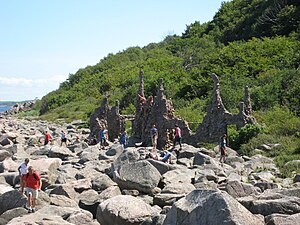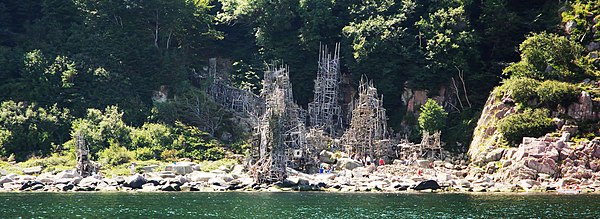Micronations/List of already existing micronations/Ladonia
Ladonia is a micronation, proclaimed in 1996 as the result of a years-long court battle between artist Lars Vilks and local authorities over two sculptures.[1] The claimed territory is part of the natural reserve of Kullaberg in southern Sweden.
History
[edit | edit source]In 1980, artist Lars Vilks began construction of two sculptures, Nimis (Latin for "too much", a structure made of 75 tonnes of driftwood) and Arx (Latin for "fortress", a structure made of stone), in the Kullaberg nature reserve in north-west Skåne, Sweden. The location of the sculptures is difficult to reach, and as a consequence they were not discovered for two years, at which point the local council declared the sculptures to be buildings, the construction of which was forbidden on the nature reserve, and demanded that they should be dismantled and removed. Despite the confrontations with the local council, a large percentage of the local community supports the sculptures, especially people working in the tourism industry.[2]


Vilks appealed the decision of the council, but lost. He appealed repeatedly, and finally the case was settled, in the council's favour, by the Swedish government. However, in the meantime Nimis had been bought from Vilks by the artists Christo and Jeanne-Claude after the death of Joseph Beuys, who bought it in 1984. On 2 June 1996, in protest of the local council, Vilks declared the area surrounding Nimis an independent, sovereign country named Ladonia.[3]
In 1999, another sculpture, Omphalos (named after Omphalos, a small sculpture in the temple at Delphi, "marking the centre of the world"), was created. It was made of stone and concrete, 1.61 metres high and weighing a tonne. The Gyllenstiernska Krapperup Foundation, formed to promote art and culture, accused Vilks of building this sculpture and complained to the police, and in August 1999 the district court ordered its removal. The Foundation had also demanded the removal of Nimis and Arx, but the court ruled against it. The Foundation appealed this decision to the Supreme Court, who eventually ruled against it. The police were unable to positively identify Vilks as the sculptor, but the district court held that he was.
The removal of Omphalos was itself controversial. Vilks was ordered to find an acceptable way to remove the sculpture. He proposed blowing it up on 10 December 2001, Nobel Day and the 100th anniversary of the Nobel Prize, and applied to the county council for permission to do so. The county council made a decision on 7 December, but kept it secret until 10 December. By that time, another artist, Ernst Billgren, had bought Omphalos from Vilks, and had requested that it not be damaged. In the early hours of 9 December, a crane boat was sent (by DYKMA, under contract from the Enforcement Administration) to the site and removed the sculpture (at a cost of SEK 92,500, billed to Vilks).[4] Despite the new owner's request, the sculpture was damaged by handling. In response to this, the Enforcement Administration was satirically declared to be "Performance Artist of the Year" in 2002.
Afterwards, Vilks applied to the county council again, this time for permission to erect a memorial in the place that Omphalos had stood. Permission was granted by the council to erect a monument no greater than 8 centimetres high. This was duly done, and the monument was inaugurated on 27 February 2002.
The ensemble Neurobash performed in Ladonia during the 10th Anniversary celebrations in 2006.[5]
Government
[edit | edit source]
The government of Ladonia is jointly led by a Queen and a President. The President and Vice-President are elected tri-annually, while the Queen, once crowned, reigns for life. As of 2018[update] the position of President is held by Interim-President The President's Old Shoes, and the Vice-President position is vacant, pending new elections in 2019.[6] Vilks, the State Secretary, performs or oversees many of the day-to-day operations of the microstate, including processing new citizenship applications and posting photos and news items to the Ladonian online "newspaper". The Cabinet Ministers are the legislative body in Ladonia, and they participate in debates and vote on proposals via the Internet. Many Ladonian ministries have artistic connotations and whimsical names.[7]As of 2018 the Cabinet of Ladonia has voted to amend the constitution to create the position of Prime Minister. The PM candidates will be nominated by and selected from current members of the Cabinet. The amendment abolishes the positions of President and Vice-President. This move was made as a way to prevent the election fraud that occurred in the previous election.
Demographics
[edit | edit source]When it was created, Ladonia had no population. As of 2016, there are 17,752 Ladonian citizens from more than 50 countries. None of the citizens resides within Ladonia's borders,[8] although there has been at least one resident citizen in the past.[9] Ladonia coexists as both a physical territory and as a large and active online community that resembles a third place, distinguishing itself from other micronations, which are either active online communities or claim small physical territories.[1]
A comparison can be drawn between Ladonia accepting online citizenship applications and the E-Residency of Estonia.[1] Virtual residency program shows how established nations may also adopt similar strategies to micronation, providing an example of what citizenship might look like in postnationalism.[10]
Nimis
[edit | edit source]Nimis is a series of wooden sculptures situated along the coast in the Kullaberg Nature Reserve, Höganäs Municipality, in the northern part of Skåne County, Sweden. They are a massive, wooden labyrinthine structure connected by several wooden towers, and are said to be mostly constructed from driftwood.
They were begun by the artist Lars Vilks in 1980 and have been the subject of a long-running legal dispute between the Swedish authorities and the artist. As no permission was given to build on the site within the nature reserve, the County Administrative Board in Skåne has sought to have Nimis demolished, despite the fact that it has become a popular tourist attraction.
As Nimis's existence is not sanctioned by Sweden, it is difficult to find – there are no official sign posts in Sweden, nor is it marked on maps. However, it can be found on Google Maps.[11] It lies a few kilometres northwest of the town of Arild and somewhat farther from the town of Mölle, and can only be reached on foot following a well-worn path with yellow Ns painted on trees and fences. The path begins as an easy stroll past Himmelstorp, a well-preserved eighteenth-century farmstead, but quickly becomes a steep and rocky climb down to the coast. Reportedly, thousands of local and international tourists visit Nimis each year, especially during summer.[12][4]

References
[edit | edit source]- ↑ a b c Bicudo de Castro, Vicente; Kober, Ralph (2019-04-15). "The Royal Republic of Ladonia: A Micronation built of Driftwood, Concrete and Bytes" (PDF). Shima: The International Journal of Research into Island Cultures. doi:10.21463/shima.13.1.10.
- ↑ Paíno, Alba Cano; Pocasangre, Ana Vilma Henríquez; Suárez, Daniel Martínez. "European Charter for Sustainable Tourism in Kullaberg Nature Reserve – Preliminary diagnosis" (PDF). Kullaberg Nature Reserve.
- ↑ "History of Ladonia". Ladonia.
- ↑ a b Scherdin, Mikael (2011). Art Entrepreneurship. Zander, Ivo. Cheltenham: Edward Elgar Pub. ISBN 9781849808507. OCLC 714568589.
- ↑ Hallerton, Sheila; Hill, Matt (2019-04-15). "Soundtracking a Micronation: Neurobash's engagement with Ladonia" (PDF). Shima: The International Journal of Research into Island Cultures. doi:10.21463/shima.13.1.11.
- ↑ "The President and Vice President". Ladonia. Retrieved 2018-10-29.
- ↑ "The constitution of Ladonia – Ladonia State Affairs". Ladonia New Herald. 2009-07-09.
- ↑ Ladonia's population chart on www.ladonia.org
- ↑ Lars Vilks (29 November 2009). "President Election: Candidates – Election 2010 – Ladonia New Herald". Ladonia New Herald. Retrieved 14 April 2015.
- ↑ Keating, Joshua (26 June 2018). Invisible countries : journeys to the edge of nationhood. Nelson, Bill (Cartographer). New Haven. ISBN 9780300235050. OCLC 1041140240.
- ↑ "The Royal Republic of Ladonia on Google Maps".
- ↑ Stebleton, Michael (2016). "Challenging Students to Become Reasonable Adventurers". About Campus: Enriching the Student Learning Experience. 21 (4): 14–21. doi:10.1002/abc.21246.